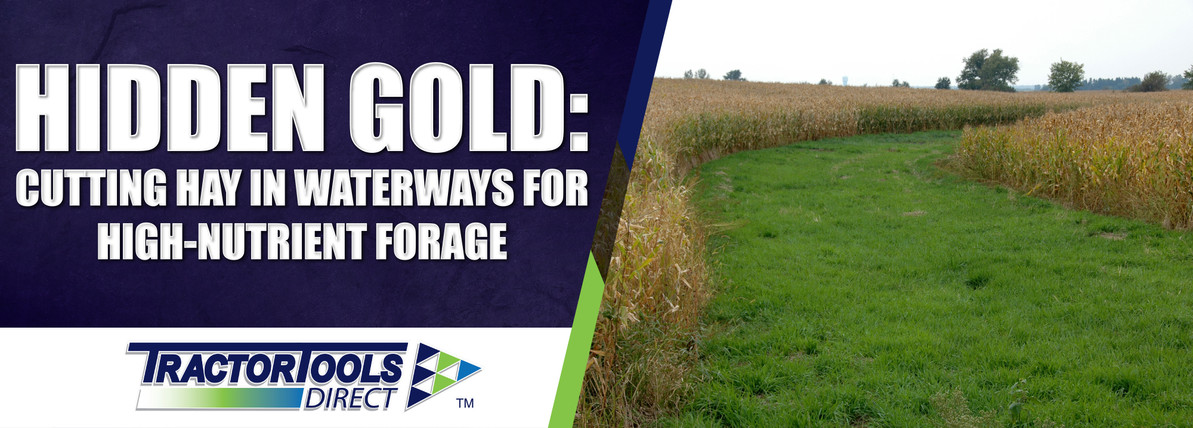Hidden Gold: Cutting Hay in Waterways for High-Nutrient Forage
On many small farms, waterways, buffer strips, and other marginal areas are often overlooked. They may be too narrow or damp for row crops. But with the right approach these spaces can produce surprisingly nutrient-rich hay–especially valuable for cattle. With proper timing and compact equipment from Tractor Tools Direct, turning these areas into productive forage zones is both smart and sustainable.
Why Waterway Hay is Worth the Effort
Hay grown in waterways tends to be higher in nutritional value for a few key reasons: - Soil fertility is typically high due to natural nutrient runoff.
- Moisture availability leads to lush, leafy growth.
- Diverse plant species, including legumes and native grasses, contribute to protein content.
In fact, hay harvested from these areas often tests higher in total digestible nutrients (TDN) and crude protein than hay grown in drier upland fields.
When to Cut Waterways for Best Results
To make the most of this hidden forage, aim to cut during the boot stage–just before grasses form seed heads. This is when nutritional value is highest. Avoid mowing when the soil is saturated to prevent rutting and compaction, which can harm both forage and soil health.
Need more guidance on timing? Check out our blog: When to Cut: A Guide to Timing Your Hay Harvest
The Right Hay Tools for Tight, Uneven Terrain
Waterways often have uneven terrain and limited access, making compact, durable equipment essential:
- The Ibex TX45 Drum Mower is lightweight and designed for small tractors, yet tough enough to handle thick grass and uneven ground.
- After cutting, the Ibex TS110 2-Rotor Tedder spreads the hay for faster drying–even in damp areas.
- When the tedder has done its job, raking will windrow the hay for baling. A great rake for this job would be the Ibex TM51 2 Wheel Rake.
- Once cured, the Ibex TX31 Mini Round Baler with Twine Wrap makes compact easy-to-handle bales perfect for storing or feeding.
Extra Forage, Extra Benefits
Cutting hay in waterways not only increases your forage supply–it also helps control invasive species, supports healthy root systems, and aligns with conservation programs like The Environmental Quality Incentives Program or Conservation Stewardship Program. You can improve your land and your livestock’s nutrition in one pass.
Ready to Make the Most of Your Margins?
Explore our full range of hay equipment to get started. With the right tools, your waterways can work harder for your farm.
FAQs
Can I cut hay in waterways?
Yes! Waterways and buffer strips can produce high-quality hay, especially for cattle. With the right timing and equipment, these areas can be productive forage sources.
Is hay from waterways safe for cows?
Yes, as long as the grass is properly dried and free of mold. Hay from waterways is often nutrient-rich and highly palatable for cattle.
What equipment do I need to cut hay in tight or uneven areas?
Compact tools like Ibex TX45 Drum Mower and Ibex TX31 Mini Round Baler are ideal for cutting and baling hay in narrow or wet zones.
When is the best time to cut hay on buffer strips or waterways?
Cut during the boot stage, before grasses go to seed, to maximize nutrition. Avoid cutting when the solid is wet to prevent damage.
Does waterway hay have more nutrients?
Often, yes. Waterway hay can be higher in protein and digestibility because of better soil moisture, fertility, and plant diversity
How do I dry hay quickly in damp areas?
Use a hay tedder like the Ibex Ts110 2-Rotor Tedder to fluff and spread hay for faster drying, even in low-lying or humid zones.
Can cutting hay in waterways help with land management?
Yes. Mowing buffer zones can reduce weeds, control erosion, and support conservation goals – not to mention the economic benefit of allowing more land to be brought into production. Some programs even offer funding for these practices.
What kind of hay bales work best for small waterway areas?
Mini round bales are perfect. They’re easier to handle and store, especially when produced with compact balers like the Ibex Tx31. This baler is designed to reach small, hard-to-reach areas often typical with waterway pastures.
Have questions or want more information? Give us a call at 260-BALE-HAY to talk to one of our customer service representatives. We will be happy to help you find the perfect equipment for your small farm’s specific baling needs! Happy Haying!
Recent Posts
-
Best Front Loader Attachments for Your Kubota BX Series Tractor
If you own a Kubota BX-series compact tractor, you already know it’s a versatile machine — but p …Dec 30th 2025 -
Boost Pine Straw Production Efficiency with Ibex Mini Round Balers
At Tractor Tools Direct, we're known for our high-quality hay equipment tailored for small farms …Dec 8th 2025 -
How to Winterize Your Tractor: Essential Maintenance Tips to Protect Your Investment
Farm equipment is one of the most valuable investments a farmer can make. At Tractor Tools Direc …Dec 1st 2025




